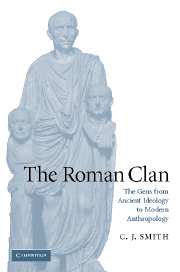Book contents
- Frontmatter
- Contents
- List of illustrations
- Preface
- List of abbreviations
- General introduction
- Part I THE EVIDENCE FOR THE GENS
- Part II TOWARDS AN INTERPRETATION OF THE GENS
- Chapter 5 The Roman community
- Chapter 6 The Roman curiae
- Chapter 7 The patricians and the land
- Chapter 8 The patriciate
- Chapter 9 Warfare in the regal and early Republican periods
- Chapter 10 Explaining the gens
- Chapter 11 Roman history and the modern world
- Appendix 1 Dionysius of Halicarnassus on the Roman curiae and religion
- Appendix 2 The missing curiae
- Select bibliography
- General index
- Index of ancient persons
- Index of passages discussed
Chapter 6 - The Roman curiae
Published online by Cambridge University Press: 22 September 2009
- Frontmatter
- Contents
- List of illustrations
- Preface
- List of abbreviations
- General introduction
- Part I THE EVIDENCE FOR THE GENS
- Part II TOWARDS AN INTERPRETATION OF THE GENS
- Chapter 5 The Roman community
- Chapter 6 The Roman curiae
- Chapter 7 The patricians and the land
- Chapter 8 The patriciate
- Chapter 9 Warfare in the regal and early Republican periods
- Chapter 10 Explaining the gens
- Chapter 11 Roman history and the modern world
- Appendix 1 Dionysius of Halicarnassus on the Roman curiae and religion
- Appendix 2 The missing curiae
- Select bibliography
- General index
- Index of ancient persons
- Index of passages discussed
Summary
INTRODUCTION
‘It is perhaps no exaggeration to say that we would know how the archaic Roman institutions worked if we knew what the Curiae were’, wrote Momigliano in 1963, before commencing a review of what he himself described as the ‘very unsatisfactory evidence’. Several subsequent attempts have been made to resolve the issues which Momigliano identified, and in each of them the curiae are central to an understanding of archaic Rome. In 1970, R. E. A. Palmer argued for the centrality of the curiate constitution; in 1990, R. E. Mitchell made the curiae a key military institution; and more recently, A. Carandini has set the curiae at the heart of his reconstruction of Rome. Moreover, recent excavations claim to have revealed the site of the Curiae Veteres, a discovery which has prompted further speculation.
It may seem however that this discussion takes us far away from the gens and is an irrelevant intrusion into the argument. It is important therefore to set out from the beginning the way that the curiae allegedly interact with the gentes. This chapter will demonstrate that many of those interactions are modern guesses, and that the relationship has to be rethought, which itself has very important consequences for the reconstruction of the gens. In addition, our consideration of the way in which the Attic genos has been understood within the wider context of Athenian society indicates the need for such analysis in relation to the gens.
- Type
- Chapter
- Information
- The Roman ClanThe Gens from Ancient Ideology to Modern Anthropology, pp. 184 - 234Publisher: Cambridge University PressPrint publication year: 2006

